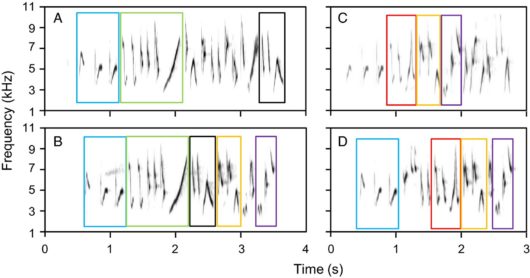LINKED PAPER
Rufous‐capped Warblers Basileuterus rufifrons show seasonal, temporal and annual variation in song use. Demko, A.D. & Mennill, D. J. 2019. IBIS. DOI: 10.1111/ibi.12666 VIEW
Many species of the wood-warbler family Parulidae have specific songs for different occasions. Male birds use two distinct collections of songs – so-called ‘singing modes’ – depending on the context (Spector 1992). Type I songs are mostly sung during the day in interactions with females, while Type II songs are used at dawn when interacting with other males. These singing modes have been described for several migratory and resident species in North America, but it is unknown whether tropical wood-warblers do the same. Two Canadian ornithologists explored this mystery by characterizing the singing behavior of the Rufous-capped Warbler (Basileuterus rufifrons) in Costa Rica.
Syllables
From 2013 to 2015, Alana Demko and Daniel Mennill recorded the songs of 50 male Rufous-capped Warblers in the Aréa de Conservación Guanacesta, a nature reserve in northwestern Costa Rica. Analyses of the recordings showed that these small passerines have large, complex repertoires of songs that are produced by combining about 45 distinct syllables in a myriad of ways. Although the birds varied the song structure depending the social context, the season and the time of day, the researchers could not find evidence for particular singing modes.
Figure 1 Sonograms of four song variants of one male Rufous-capped Warbler. Different syllables are marked with colored boxes.
Neighbors
So, in contrast to its temperate relatives, the Rufous-capped Warbler does not seem to use singing modes. However, the males of this species do adjust their song production in some cases. Males sing most at dawn during the breeding season, probably because they are defending their territories against rival neighbors (e.g., Liu 2004). Interestingly, the birds tended to share many syllables with their neighbors, suggesting that they are adjusting their songs to match those of the bird next door. How this syllable sharing affects the outcomes of male-male disputes at territory edges remains to be investigated (Beecher & Brenowitz 2005).
Figure 1 Males sing more at dawn during the breeding season (B) compared to the non-breeding season (A).
Females prefer short songs
When a female bird was vocalizing nearby, males quickly switched to shorter songs. Perhaps females prefer a shorter song because it allows them to more easily compare males and pick the highest quality singer (Price 2013). Moreover, shortened songs could stimulate the female during her fertile period, increasing the males’ chances for copulation (Nelson & Poesel 2011). And a short song is less likely to attract other males – which mainly react to the longer songs used in territory defense – that might distract the female. So, although the Rufous-capped Warbler does not have distinct singing modes, it still needs to carefully pick the right song to sing.
References
Beecher, M. D., & Brenowitz, E. A. (2005). Functional aspects of song learning in songbirds. Trends in ecology & evolution 20: 143-149. VIEW
Liu, W. C. (2004). The effect of neighbours and females on dawn and daytime singing behaviours by male chipping sparrows. Animal Behaviour 68: 39-44. VIEW
Nelson, D. A., & Poesel, A. (2011). Song length variation serves multiple functions in the white-crowned sparrow. Behavioral Ecology and Sociobiology 65: 1103-1111. VIEW
Price, J. J. (2013). Why is birdsong so repetitive? Signal detection and the evolution of avian singing modes. Behaviour 150: 995-1013. VIEW
Spector, D. A. (1992). Wood-warbler song systems. In Current ornithology (pp. 199-238). Springer, Boston, MA. VIEW
Featured image: Rufous-capped Warbler Basileuterus rufifrons | Francesco Veronesi| CC BY-SA 2.0 Wikimedia Commons








